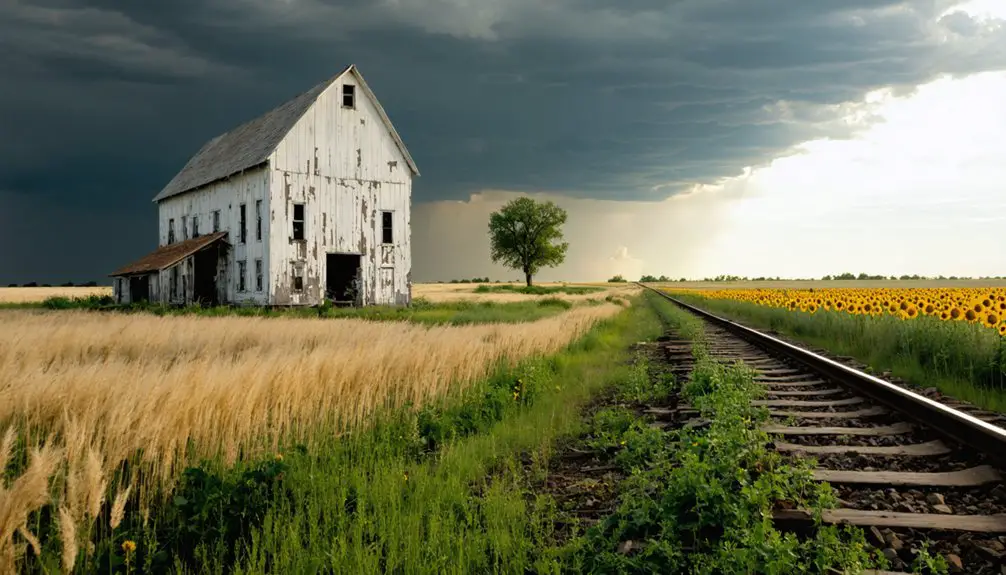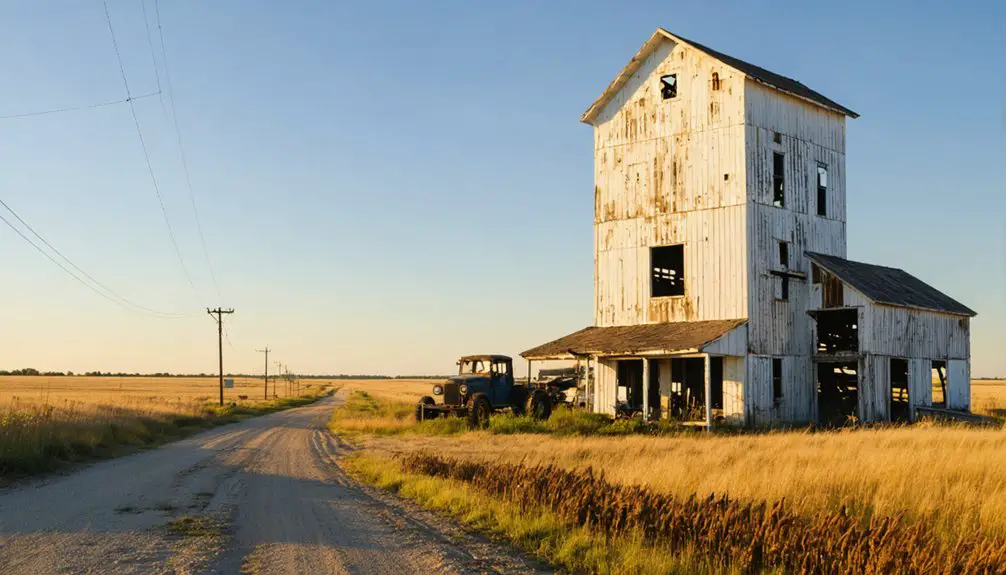You’ll find Heaton, North Dakota’s ghost town story particularly dramatic, as this once-thriving railroad settlement met its fate after a catastrophic 1907 tornado. Founded in 1899 by the Northern Pacific Railroad, Heaton flourished with 400 residents, multiple businesses, and three churches at its peak. The tornado destroyed critical infrastructure, including the post office, bank, and grain elevators, triggering a century of decline. By 2010, only one family remained in this haunting reminder of prairie town resilience.
Key Takeaways
- Founded in 1899 by Northern Pacific Railroad, Heaton was a thriving transportation hub in Wells County with a peak population of 400.
- A devastating tornado in 1907 destroyed key infrastructure, triggering permanent population decline and economic collapse.
- The town featured essential services including hotels, churches, a bank, and grain elevators before its decline.
- By 2010, Heaton had become a ghost town with only one remaining family amid deteriorating buildings and abandoned structures.
- The town’s history is preserved primarily through digital documentation, photography collections, and oral histories from former residents.
Railroad Beginnings and Early Settlement
When the Northern Pacific Railroad established Heaton in 1899, it marked another strategic point along their expanding rail network through Dakota Territory. Named after George Heaton, the railroad’s land sales manager, the town emerged as an essential transportation hub in southern Wells County.
The railroad significance became immediately apparent as you’d witness early settlers, including English immigrants and homesteaders, flocking to the area. The town’s prosperity continued until a devastating tornado in 1907 dramatically altered its trajectory.
The railroad’s arrival brought waves of hopeful settlers seeking new lives in Dakota Territory’s promising frontier lands.
You’ll find that before widespread road infrastructure, the Northern Pacific’s presence was critical, enabling the movement of people, grain shipments, and important supplies.
The railroad’s land grants, secured in the early 1870s, allowed them to promote settlement and establish key points along their route. By reaching the Red River in 1871 and Bismarck’s Missouri River by 1873, they’d created the foundation for Heaton’s future development.
During its peak, three bustling churches served the spiritual needs of the growing community, demonstrating the town’s vibrant social life.
Life During the Glory Days
The bustling streets of Heaton during its peak years painted a vibrant picture of small-town prosperity in early 20th century North Dakota.
You’d find a thriving community of 400 residents served by two hotels, three churches, and essential businesses like the Farmer’s Union Bank and a well-stocked hardware store. The town’s post office and lumberyard kept commerce flowing, while the gas station connected locals to the wider world.
Community gatherings and social events centered around the churches, with Saturday nights drawing folks from surrounding farms into town. The town grew into a regional hub after being established as the first town in 1899.
You’d see farmers selling their produce at weekend markets, catching up at cream sales, and conducting business at the bank. Life revolved around the railroad and agriculture, with Main Street serving as the heart of daily commerce and socializing. Today, only one family remains in the once-bustling community, surviving with basic amenities like a cistern water system.
The Devastating 1907 Tornado
In 1907, a devastating tornado struck Heaton, causing widespread destruction to the town’s infrastructure including homes, businesses, and public buildings that had been crucial to the community’s vitality. Like the tornado at Walcott in 1955 that caused devastating damage, the Heaton storm left catastrophic destruction in its wake.
You’ll find that residents faced immediate hardships of homelessness and disrupted livelihoods, with many businesses never reopening after the disaster. Similar to the aftermath of storms in rural areas where tornado awareness improved after 1953, the community struggled to rebuild and recover.
The tornado’s impact proved to be a turning point in Heaton’s history, as numerous families chose to relocate elsewhere, marking the beginning of the town’s gradual decline toward abandonment.
Immediate Impact and Destruction
During a catastrophic afternoon in 1907, a powerful tornado tore through Heaton, North Dakota, releasing widespread destruction that forever altered the town’s trajectory.
The tornado’s devastating impact left an indelible mark on the community’s infrastructure, demolishing essential establishments and disrupting daily life. You’d have witnessed the obliteration of fundamental structures that formed the backbone of this once-thriving town. The tragic event would later be preserved in digital collections software through CONTENTdm.
- The post office, bank, lumberyard, hardware store, and gas station were completely destroyed.
- Two hotels and three churches, central to community life, suffered extensive damage.
- Multiple grain elevators, critical to the local farming economy, were reduced to rubble.
The tornado destruction tested community resilience as families lost their homes and businesses, forcing many to make difficult decisions about rebuilding or relocating to other towns.
Community Response and Recovery
Following the devastating 1907 tornado, Heaton’s residents demonstrated remarkable resilience by mobilizing immediate community response efforts. Displaying strong community solidarity, locals formed groups to assist with rescue operations and debris removal, while neighboring towns sent volunteers and crucial supplies.
You’ll find that mutual aid emerged as residents established temporary shelters in surviving buildings and distributed food, water, and basic medical assistance. Similar to the extended power outages experienced during the 2025 storms, the town faced prolonged disruption of basic services.
The recovery process proved challenging as the town faced significant obstacles. Limited financial resources and inadequate insurance coverage hampered rebuilding efforts.
While community members worked tirelessly to restore essential services and repair key structures like churches and grain elevators, many business owners chose to relocate.
Despite attempts to rebuild through government aid programs and grants, Heaton struggled with continued population decline and fractured community bonds.
Lasting Effects on Population
The devastating 1907 tornado sparked an immediate and permanent population decline in Heaton, as widespread destruction of homes, businesses, and essential infrastructure left residents with few options but to relocate.
In the tornado aftermath, you would’ve witnessed a mass exodus that transformed this once-thriving farming community. Like the tragic Wichita Falls disaster that saw residents fleeing to shelters, the widespread population relocation created a ripple effect of economic decline, as abandoned properties led to tax forfeitures and county seizures. Similar to case studies published by WM. F. Reed Jr. that documented survivor accounts, the impact on Heaton’s community was profound.
- Three churches and two hotels that once served the community were lost or severely damaged.
- Multiple key structures including stores, the lumberyard, bank, and grain elevators were destroyed.
- The loss of housing and workplaces removed any incentive for rebuilding or returning.
Today’s ghost town status directly reflects this devastating event’s lasting impact on Heaton’s population and infrastructure.
Community Infrastructure and Services
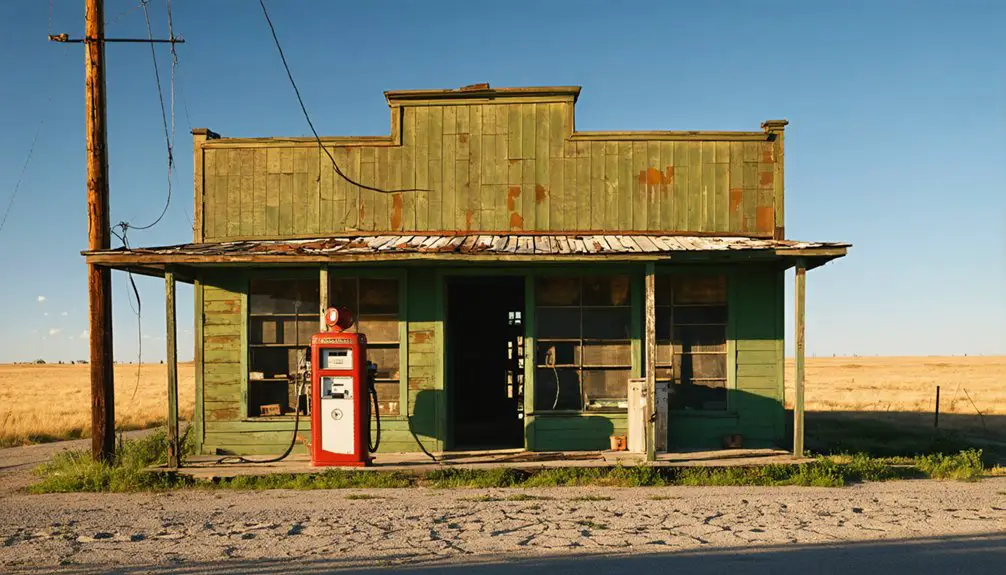
As Heaton flourished in its early years, the town developed a robust infrastructure centered around essential services for its residents and the surrounding farming community.
You’d have found a post office serving as your primary communication hub, alongside the Farmer’s Union Bank handling agricultural transactions. The town’s community services included three churches catering to different denominations, while retail establishments met your daily needs through a hardware store, gas station, lumber yard, and general store.
However, infrastructure challenges emerged following the 1907 tornado and railroad disruptions.
As the Northern Pacific Railroad’s presence diminished, the town’s crucial services began to falter. By the early 2000s, you’d have witnessed the disconnection of water services, closure of financial institutions, and abandonment of retail buildings, marking the erosion of Heaton’s once-thriving infrastructure.
Signs of Decline and Abandonment
If you visit Heaton today, you’ll find numerous dilapidated structures that have deteriorated over a century of neglect, with many buildings destabilized by the devastating 1907 tornado.
The town’s physical decay accelerated as its population dwindled, with younger residents moving away and older ones passing on, until by 2010 only one family remained.
Many original buildings have vanished entirely, either through demolition by county authorities due to tax forfeiture or through vandalism and scavenging of abandoned properties.
Physical Structure Deterioration
Decades of abandonment have transformed Heaton’s buildings into stark symbols of decay, with dilapidated structures dominating the ghost town’s landscape.
You’ll find the abandoned structures in various states of collapse, weakened by North Dakota’s harsh weather and the relentless march of time. Since the early 2000s, many buildings have been razed or burned due to safety concerns, while others have succumbed to nature’s reclamation.
- Environmental factors like the 1907 tornado, freezing winters, and storms have accelerated the deterioration of wooden frames and masonry.
- Vandalism and looting have compromised remaining buildings through broken windows and doors.
- Infrastructure has vanished entirely, with former utility lines corroding underground and roads falling into disrepair.
Population Loss Patterns
While Heaton’s population peaked at around 400 residents in 1930, the town experienced a dramatic exodus that reduced its numbers to just 62 people by 1960 and merely 5 by 2004.
The demographic shifts in Heaton followed a devastating tornado between 1907-1910, which destroyed homes and businesses, forcing many residents to permanently relocate.
Economic challenges mounted as the town’s railroad-based economy weakened, leading to the closure of essential businesses including the post office, lumber yard, bank, and hardware store.
You’ll find that this downward spiral accelerated with unpaid property taxes, resulting in county-seized lots and demolished structures.
Final Days of a Prairie Town
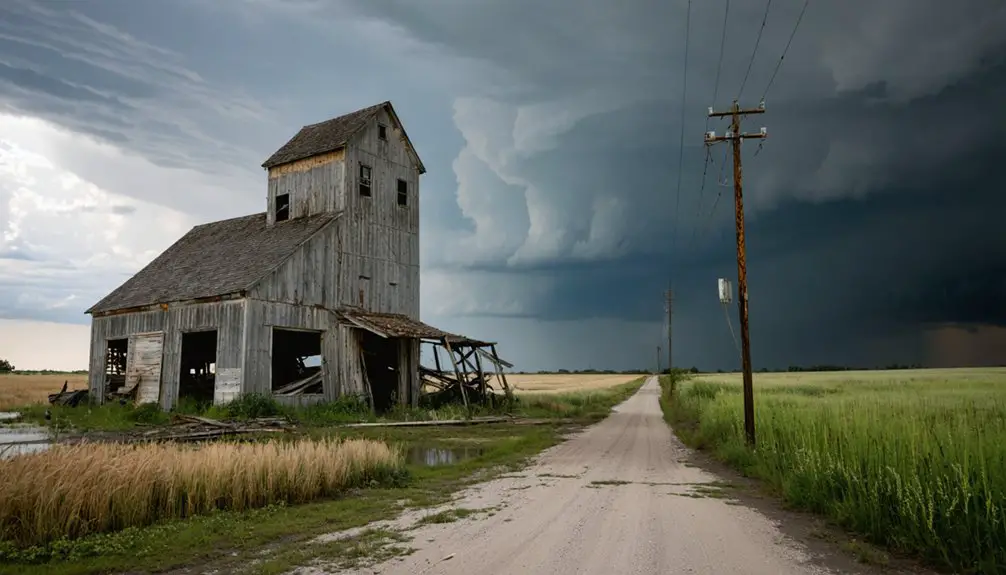
As Heaton entered its final chapter in the early 2000s, the once-bustling prairie town had dwindled to just one permanent resident.
The final memories of this prairie settlement were marked by systematic dismantling, as township voters approved the demolition of unsafe structures, and the county reclaimed tax-forfeited properties.
You’d find ghostly echoes of the past in the disappearing landmarks that once defined this railroad community.
- All utilities were disconnected, making remaining buildings uninhabitable
- Historic structures vanished through demolition between 2000-2010
- Local authorities removed hazardous buildings to prevent scavenging
What you’re witnessing is the deliberate dissolution of a community that once boasted hotels, churches, and thriving businesses – all casualties of economic decline, natural disaster, and the inevitable march of time.
Preserving Heaton’s Legacy
Despite limited formal preservation efforts, Heaton’s legacy survives primarily through digital documentation and scattered historical records.
You’ll find the town’s final years captured through organizations like Ghosts of North Dakota, whose photographers documented the remaining structures between 2004 and 2010.
While local residents chose to demolish many abandoned buildings for safety reasons, digital preservation has become essential in maintaining Heaton’s memory.
Oral histories from the last resident and visitors provide valuable first-hand accounts of life in this prairie town.
Though the community lacks official historic registry status, you can still piece together its story through online collections and narratives.
The township’s practical approach to managing the site reflects a common pattern among North Dakota’s abandoned towns, where resources for physical preservation remain scarce.
Regional Impact and Historical Significance
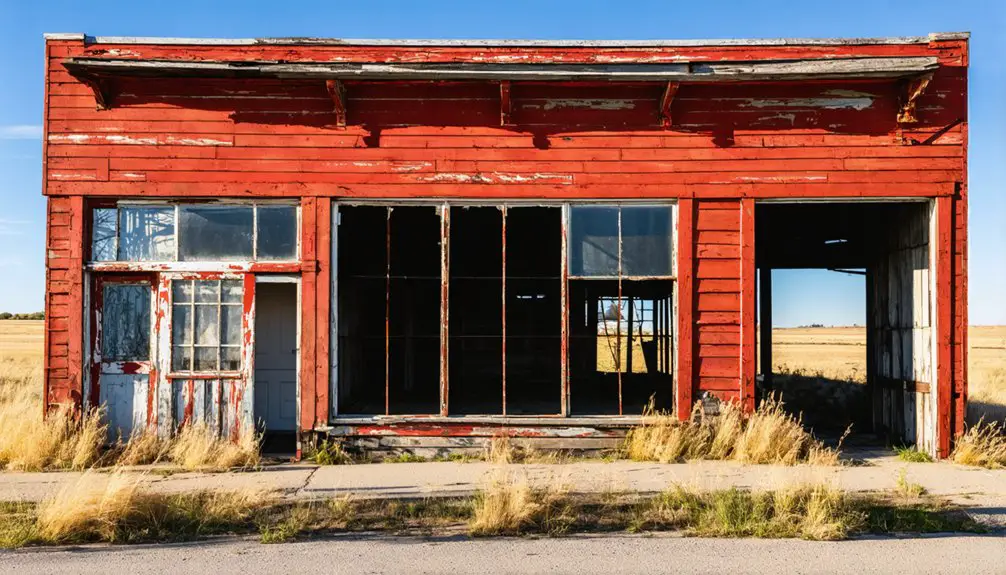
Since its establishment alongside the Northern Pacific Railroad in 1899, Heaton exemplified both the rise and decline of North Dakota’s rural communities.
You’ll find that the town’s economic resilience was deeply tied to its railroad connectivity, supporting regional agriculture through grain elevators and essential services. The town’s cultural heritage lives on through its compelling story of resilience and adaptation.
- The devastating 1907 tornado marked a turning point, triggering population decline from 400 residents to nearly zero.
- Heaton’s transformation mirrors broader regional shifts in North Dakota, including rural exodus and changing transportation patterns.
- The town’s infrastructure evolution, from a bustling hub with multiple businesses to abandoned structures, reflects the changing dynamics of modern agricultural communities.
Frequently Asked Questions
Are There Any Remaining Descendants of Original Heaton Settlers Still in North Dakota?
While descendant stories aren’t officially documented, you’ll find anecdotal evidence suggesting some family ties continued through the mid-1900s, including the Hawks family who maintained connections until the early 2000s.
What Happened to the Town’s Cemetery and Burial Records?
Like a steadfast guardian, Heaton Cemetery still stands with about 337 documented burial records. You’ll find them preserved online through Find a Grave, while the Wells County Museum maintains historical documentation.
Did Any Movies or Documentaries Feature Heaton’s Ghost Town Story?
You’ll find no major documentaries dedicated solely to Heaton’s history, though “Ghosts of North Dakota” YouTube channel extensively documented the ghost town through video visits in 2004 and 2010.
Were There Any Notable Crimes or Mysterious Events in Heaton’s History?
You won’t find any documented unsolved mysteries or ghost sightings in historical records. The town’s story centers on natural disasters and economic decline rather than criminal or supernatural events.
What Native American Tribes Originally Inhabited the Area Before Heaton’s Founding?
Like eagles circling Hawksnest’s sacred mounds, you’d find Dakota (Sioux) as the dominant Native tribes, alongside Assiniboine and Cheyenne hunters, while Mandan, Hidatsa, and Arikara farmers settled nearby riverlands.
References
- https://www.thehistoryhandbook.com/2022/welcome-to-heaton/
- https://ghostsofnorthdakota892857007.wordpress.com/2004/05/01/heaton-nd/
- https://ghostsofnorthdakota892857007.wordpress.com/2010/05/23/heaton-six-years-later/
- https://ominous.app/browse/site/18381
- https://northernsentry.com/2025/06/26/north-dakota-ghost-towns/
- https://www.history.nd.gov/hp/PDFinfo/North-Dakota-Railroads-MPDF-Final-corrected.pdf
- http://genealogytrails.com/ndak/wells/history.html
- https://www.history.nd.gov/archives/manuscripts/inventory/10157counties/10157 Wells.html
- https://www.tornadoproject.com/alltorns/worstts.htm
- https://www.statehistoricalfoundation.org/todayinndhistory/?offset=100
